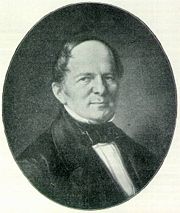
Eduard Knoblauch
Encyclopedia




Berlin
Berlin is the capital city of Germany and is one of the 16 states of Germany. With a population of 3.45 million people, Berlin is Germany's largest city. It is the second most populous city proper and the seventh most populous urban area in the European Union...
; d. May 29, 1865, in Berlin) was a German
Germans
The Germans are a Germanic ethnic group native to Central Europe. The English term Germans has referred to the German-speaking population of the Holy Roman Empire since the Late Middle Ages....
architect
Architect
An architect is a person trained in the planning, design and oversight of the construction of buildings. To practice architecture means to offer or render services in connection with the design and construction of a building, or group of buildings and the space within the site surrounding the...
.
Eduard Knoblauch was born in his family's house on Poststraße 23 in the Nikolaiviertel
Nikolaiviertel
Founded about 1200, the Nikolaiviertel of Alt-Berlin, together with the neighbouring settlement of Cölln, is the reconstructed historical heart of the German capital Berlin...
neighborhood in Berlin
Berlin
Berlin is the capital city of Germany and is one of the 16 states of Germany. With a population of 3.45 million people, Berlin is Germany's largest city. It is the second most populous city proper and the seventh most populous urban area in the European Union...
, Germany
Germany
Germany , officially the Federal Republic of Germany , is a federal parliamentary republic in Europe. The country consists of 16 states while the capital and largest city is Berlin. Germany covers an area of 357,021 km2 and has a largely temperate seasonal climate...
. He studied at the Berliner Bauakademie under Karl Friedrich Schinkel
Karl Friedrich Schinkel
Karl Friedrich Schinkel was a Prussian architect, city planner, and painter who also designed furniture and stage sets. Schinkel was one of the most prominent architects of Germany and designed both neoclassical and neogothic buildings.-Biography:Schinkel was born in Neuruppin, Margraviate of...
successfully passing a series of examinations (1818 Feldmesserprüfung, 1822 Kondukteurprüfung, 1828 Baumeisterprüfung). He was one of the co-founders of the Architektenvereins (architects' society) in Berlin in 1824 and was on its executive board until 1862. He edited the Zeitschrift für Bauwesen (Journal for Building) for many years.
After the conclusion of his studies in 1828 he traveled in Germany and Holland. Together with fellow architect Friedrich August Stüler
Friedrich August Stüler
Friedrich August Stüler was an influential Prussian architect and builder. His masterwork is the Neues Museum in Berlin, as well as the dome of the triumphal arch of the main portal of the Berliner Stadtschloss.-Life:...
he traveled in 1829/1830 to France, Switzerland and Italy. He married Julie Verhuven in 1831 and had with her two sons and four daughters.
Works
His buildings include:- Russische Botschaft (Russian Embassy) (renovation), 1840-41 [destroyed 1945], BerlinBerlinBerlin is the capital city of Germany and is one of the 16 states of Germany. With a population of 3.45 million people, Berlin is Germany's largest city. It is the second most populous city proper and the seventh most populous urban area in the European Union...
, Germany - Schloss Görlsdorf, 1843 [destroyed 1945], AngermündeAngermündeAngermünde is a town in the district of Uckermark in the state of Brandenburg, Germany. It is located on the Mündesee, 43 miles northeast of Berlin on the Berlin–Szczecin railway...
, Germany - Schloss Kröchlendorff, 1848, NordwestuckermarkNordwestuckermarkNordwestuckermark is a municipality in the Uckermark district, in Brandenburg, Germany....
, Germany - Schloss Schlemmin, 1850, SchlemminSchlemminSchlemmin is a municipality in the Vorpommern-Rügen district, in Mecklenburg-Vorpommern, Germany....
, Germany - Schloss Lanke, (renovation), 1858, WandlitzWandlitzWandlitz is a municipality in the district of Barnim, in Brandenburg, Germany. It is situated 25 km north of Berlin, and 15 km east of Oranienburg...
, Germany - Neue Synagoge, 1859-66 [bomb-damaged 1943, rebuilt 1995], BerlinBerlinBerlin is the capital city of Germany and is one of the 16 states of Germany. With a population of 3.45 million people, Berlin is Germany's largest city. It is the second most populous city proper and the seventh most populous urban area in the European Union...
, Germany
His son Gustav (1833–1916) was also an architect, as was his grandson Arnold (1879–1963), both of Berlin. His son Carl Eduard (Charles Edward) (1837–1886) was a businessman in London and New York City.

